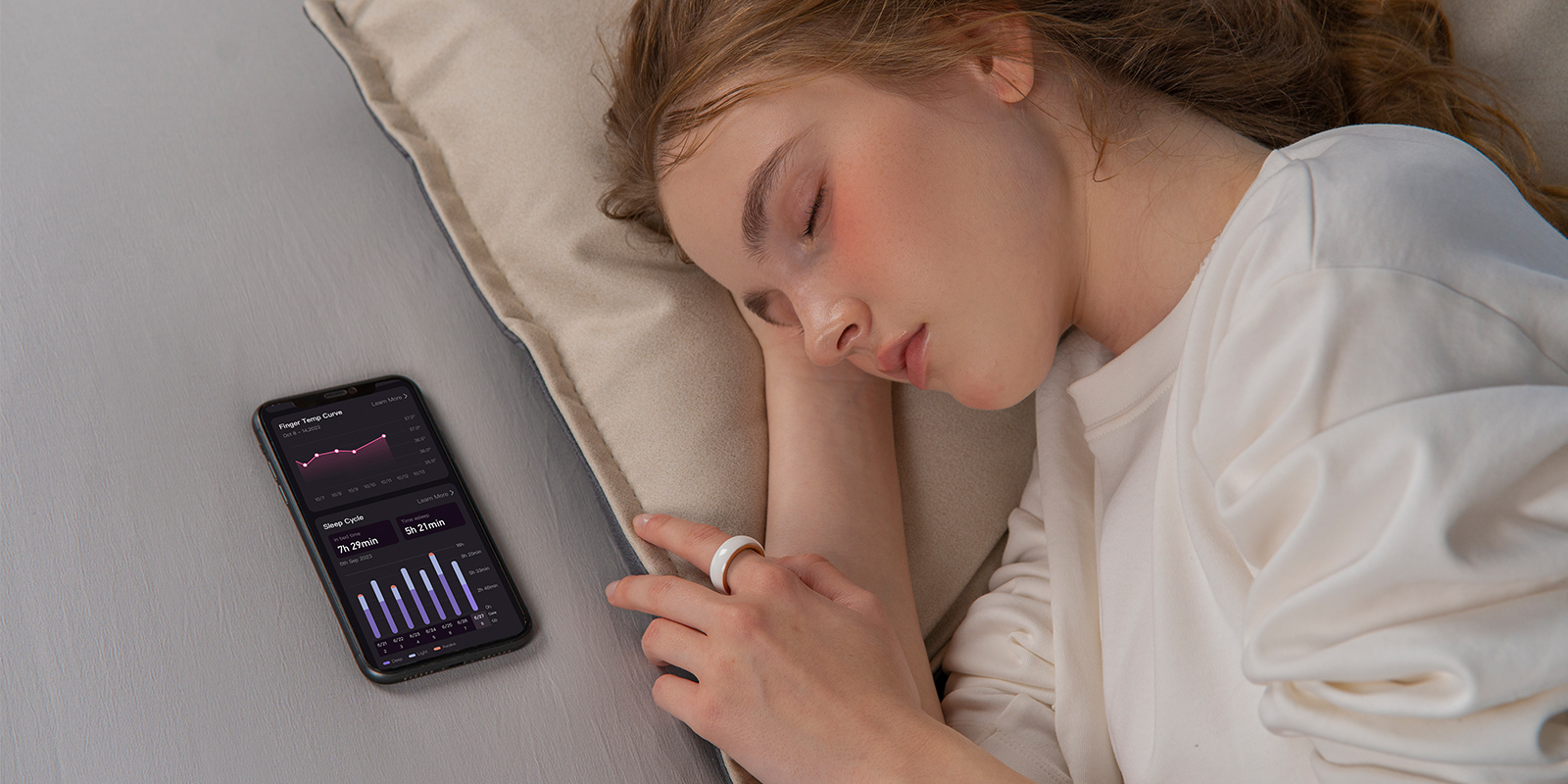Smart ovulation tracker eliminate the inconvenience associated with manual ovulation tracking methods and also provide a more accurate ovulation prediction time than manual tracking, helping women to better prepare for pregnancy or contraception. Moreover, the increasing number of innovations in women's reproductive health offers irresistible potential for the ovulation trackers market.
Developers have evolved from BBT tracking devices to electronic wearables that track body metrics, which need to be worn at night and accurately measured before waking up in the morning, so they are gradually designing wearable devices into lightweight and convenient smart rings. For example, Femometer, which is dedicated to providing data on women's health, launched the first smart ring for women, which specializes in monitoring BBT and accurately predicting the date and time point of ovulation and is also in the process of It is also developing a feature to track fitness data such as blood oxygen. It can also be synchronized with the Femometer app to monitor women's reproductive health through menstrual tracking, providing women with comprehensive health monitoring.
![]()
Smart Ovulation Tracker Market
Smart ovulation tracker is mainly for measuring basal body temperature and fertility hormone levels, which are signs of ovulation. Women can realize their fertile window and plan or avoid sexual activity accordingly.
Market Overview
According to the market report of Transparency Market Research and Polaris Market Research, the global smart ovulation trackers market is valued at $160.2 million in 2021, growing to $170.3 million in 2022. The global market is expected to grow at a CAGR of 10.7% from 2022 to 2031, and the global smart ovulation tracker market is expected to reach $428.2 million by 2031.
![]() image source: https://www.polarismarketresearch.com/industry-analysis/smart-fertility-tracker-market
image source: https://www.polarismarketresearch.com/industry-analysis/smart-fertility-tracker-market
Key market players are looking to update their existing products proactively. For instance, Samsung Electronics has partnered with Natural Cycles to add advanced temperature-based menstrual cycle monitoring to the Galaxy Watch 5 series. This technology from Natural Cycles is already used in wristwatches. The evolving technology of smart ovulation trackers will further create new growth opportunities for the market in the coming years as companies proactively update their existing products.
What are the major factors contributing to the growth of the market? Smart ovulation tracker can provide convenient, accurate, and cozy assistance to couples preparing for pregnancy due to the increase in scheduling issues and pregnancy-related difficulties faced by them in their life and work. This is one of the major drivers fueling the smart ovulation tracker market.
Region Distribution of Smart Ovulation Tracker
North America was the largest market for smart ovulation trackers by 2022 and is expected to continue growing, a trend that is expected to continue over the expected period. This is due to the popularity of mobile apps for easy access to data and health apps that have been emphasizing the importance of focusing on one's health, which has increased women's interest in reproductive health.
Femometer offers a variety of health tracking tools such as BBT thermometers, various hormone test strips kits, smart rings, and the Femometer App for women's menstrual and pregnancy tracking, as well as a pro-conversation community within the app for women to talk to each other and get support from other mothers and healthcare professionals. This will enable more consumers to understand the uses and benefits of smart fertility trackers, create health awareness, and drive the adoption of these products in the coming years.
Also, the demand for smart ovulation tracker in Europe is on a growing trend, this is due to their increasing demand for non-invasive and natural family planning, which is expected to grow rapidly in the European region. These smart ovulation tracker naturally monitor reproductive health and fertility. The trend of using wearable technology products to track fitness is driving the growth of smart fertility tracker due to people's trust in wearable tools.
North America is expected to dominate the global smart fertility tracker market over the next decade with a share of more than 30%. According to the National Center for Health Statistics of the Centers for Disease Control and Prevention, about 3.6 million babies will be born in the U.S. in 2020, a decline of about 4% from 2019.
Smart Ovulation Tracker Boost FAMS
What are Fertility Awareness Methods?
Fertility Awareness Methods (FAMs) are a method of tracking menstrual cycles and days of conception to prevent pregnancy. Fertility Awareness Methods are also known as "Natural Family Planning" and "Rhythm Methods". Fertility Awareness Methods help women track their menstrual cycles so that they know their fertile window and most fertile days to avoid unwanted pregnancies.
There are 3 standard fertility awareness methods:
Temperature method: take your temperature every morning before waking up.
Cervical mucus method: Check your cervical mucus (vaginal discharge) every day.
Calendar method: recording the menstrual cycle on a calendar.
![]()
However, all three methods are not very accurate and are extremely ineffective in avoiding unwanted pregnancies. According to a study published by the United Nations, about 7 million women have unwanted pregnancies every six months. As a result, women are using a variety of fertility awareness methods to prevent pregnancy by avoiding intercourse or using other contraceptive methods on the day of conception. The Smart Fertility Tracker can help avoid unwanted pregnancies with 99% accuracy.
Advanced Technology on Ovulation Tracking
The launch of technologically advanced fertility monitoring equipment will provide advantages to drive market development. For example, the Femometer smart ring is a wearable monitor that provides data on fertility levels as well as ovulation and menstrual cycles, as well as hormone levels. This ring is equipped with a high-precision temperature sensor, data return system, and app with long-lasting records and accurate algorithms, which can provide information about fertility accurately and quickly. Therefore, technological advancement is one of the key factors driving the demand for fertility trackers and fertility monitoring devices.
Technology Related to Smart Ovulation Trackers
BBT Tracking: Basal body temperature refers to the lowest body temperature when the human body is at rest, so it is most accurate to measure before getting up early. The smart fertility tracker has a temperature sensor that records and provides a curve of changes in basal body temperature;
Ovulation Prediction Algorithms: If you want to predict more accurately, you usually need to continue using the smart ovulation tracker for 10-15 days. The algorithm will perform high-precision calculations based on historical data recorded in the past ten days and basic information such as age and menstruation to predict ovulation: period and fertile window.
Data synchronization: The recorded data and the results generated by the algorithm cannot usually be viewed directly with the smart ovulation tracker and need to be synchronized to the corresponding app. This time the app also allows users to directly input data and also provides personalized health advice to users. You can also conveniently check your ovulation data while moving in your daily life.

LH hormone Tracking: Advanced technology can track LH hormones in women’s bodies through saliva or urine, and predict ovulation dates by recording changes in hormone levels. However, such tracking is not suitable for wearable smart devices, which are generally performed by test strips.
Wearable Ovulation Tracker
It's no surprise that the age of technology has prompted us to digitize our lifestyles as well. If it weren't for the rise of wearable technology, we'd probably still be keeping journals to keep track of what we're doing and how we're doing. Especially for women, they might still be keeping a handwritten record of their menstrual cycle.
In the field of smart ovulation trackers, small wearable devices such as rings, hair clips, and patches have become more popular than smartwatches and smartbands, and even more valuable as wearable items than traditional jewelry.
![]()
This is because while watches have been implemented to track basic body data on sleep activity, for women who need to monitor their basal body temperature, wearing a watch at night can lead to sleeplessness, and the skin covered by the band can be impermeable to air. This is, the smart ring solves this discomfort, while still being able to be used as jewelry for women to wear daily. However, there are not many smart rings specifically designed for women on the market for the time being. Femtometer, a brand specializing in providing women with health data and knowledge, has designed a smart ring, which is also essentially a smart ovulation tracker, but the design of the ring gives it an aesthetic significance, and it is also well loved by female customers.
Conclusion
As we delve deeper into the women's health technology space, it's clear that the smart ovulation tracker market is poised for significant growth and innovation. Not only are these wearable devices revolutionizing the way women monitor their reproductive health, but they are also reshaping the landscape of fertility management.
It can be seen from the market data report that the market growth trend of smart ovulation trackers is obvious, and North America will also become the leading market, which means that women’s awareness of reproductive health is also increasing with the advancement of technology.
Wearable technology is slowly infiltrating into our lives. On Reddit, a large social platform for information sharing, someone joked about the popularity of wearable technology, "I hope to have a pair of smart socks in the future to complete digital wear ables from head to toe." Although this is a joke, it may not be impossible. Of course, digitalization also has the disadvantage of often needing to charge various daily necessities, so small wearable devices like smart rings are very popular among people because of their small size and strong electronic power storage capacity. It only takes a long time to charge them. For a short time, it will not interfere with daily use. With the popularity of smart ovulation trackers, I hope that all women can pay attention to their reproductive health, increase their awareness of protecting themselves, and become better selves through scientific and healthy lifestyles.
This article is the original creation of Femometer. All rights reserved by Femometer Inc. To reproduce, distribute, or reference the content, please reach out to us in advance to prevent any potential legal issues. Copyright © Femometer Inc.








